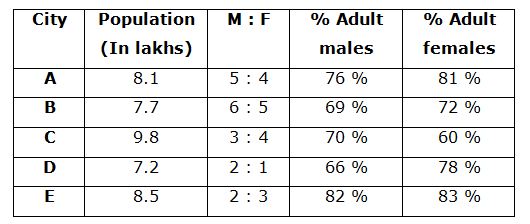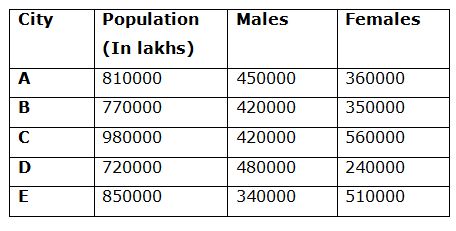SBI PO 2019 Notification will be expected soon. It is one of the most expected recruitment among the banking aspirants. Every year the exam pattern for SBI PO has been changing. Depends upon the changing of exam pattern the questions are quite harder compare to the previous year. So the questions are in high level than the candidate’s assumption.
As per the latest trend, our IBPS Guide is providing the updated New Exam Pattern Quantitative Aptitude questions for SBI PO 2019 Day 23. Our Skilled experts were mounting the questions based on the aspirant’s needs. So candidates shall start your preparation and practice on daily basis with our SBI PO pattern quantitative aptitude questions 2019 day 23. Start your effective preparation from the right beginning to get success in upcoming SBI PO 2019.
“Be not afraid of growing slowly; be afraid only of standing still”
[WpProQuiz 5449]
Click Here for SBI PO Pre 2019 High-Quality Mocks Exactly on SBI Standard
Click Here to View Quantitative Aptitude Questions in Hindi
Directions (1 – 5): The questions below are based on the given Series-I. The series-I satisfy a certain pattern, follow the same pattern in Series-II and answer the questions given below.
1)
5 7 25 131 925 8335
– ? – – – 14005
a) 24
b) 35
c) 13
d) 42
e) 38
2)
258 300 348 416 526 708 1000
116 142 – – – – ?
a) 762
b) 815
c) 927
d) 1033
e) 1128
3)
127 139 159 189 231 287 359
313 325 – – – – ?
a) 638
b) 712
c) 596
d) 545
e) 820
4)
52 51 94 255 956 4655
? – – – – -25
a) 27
b) 13
c) 32
d) 40
e) 45
5)
36000 7200 720 48 2.4
– ? – – 0.6
a) 3200
b) 2700
c) 1800
d) 3600
e) 1200
Directions (Q. 6 – 10): Study the following information carefully and answer the given questions:
The following table shows the population of different cities (In lakhs) and the ratio of males and females among them and the percentage of adult males and adult females.

6) Find the difference between the total adult males in City C to that of total adult females in City A?
a) 3400
b) 2400
c) 6500
d) 4200
e) None of these
7) Find the ratio between the total number of males to that of total number of females of all the given cities together?
a) 178: 197
b) 151: 176
c) 256: 163
d) 211: 202
e) None of these
8) Total number of minor males in City A and B together is approximately what percentage of total number of minor females in City D and E together?
a) 155 %
b) 185 %
c) 200 %
d) 170 %
e) 215 %
9) Total number of adult females in City B and C together is approximately what percentage more/less than the total number of adult males in City A and E together?
a) 5 % less
b) 15 % more
c) 15 % less
d) 30 % more
e) 5 % more
10) Find the average number of adult females in all the given cities together?
a) 324840
b) 259360
c) 389280
d) 298020
e) None of these
Answers:
Directions (1-5):
1) Answer: c)
Series I pattern:
5*1 + 2 = 7
7*3 + 4 = 25
25*5 + 6 = 131
131*7 + 8 = 925
925*9 + 10 = 8335
Series II pattern:
(14005 – 10)/9 = 1555
(1555 – 8)/7 = 221
(221 – 6)/5 = 43
(43 – 4)/3 = 13
(13 – 2)/1 = 11
The answer is 13
2) Answer: a)
Series I pattern:

The difference of difference is, 32 – 3, 52 – 5, 72 – 7, 92 – 9, 112 – 11,…
(or)
The difference of difference is, (2*3), (4*5), (6*7), (8*9), (10*11)
Series II pattern:

The difference of difference is, 32 – 3, 52 – 5, 72 – 7, 92 – 9, 112 – 11,…
(or)
The difference of difference is, (2*3), (4*5), (6*7), (8*9), (10*11)
The answer is 762
3) Answer: d)
Series I pattern:
127 + (3*4) = 139
139 + (4*5) = 159
159 + (5*6) = 189
189 + (6*7) = 231
231 + (7*8) = 287
287 + (8*9) = 359
The pattern is, +(3*4), +(4*5), +(5*6), +(6*7), +(7*8), +(8*9),…
(Or)
The difference of difference is, 8, 10, 12, 14, 16,….
Series II pattern:
313 + (3*4) = 325
325 + (4*5) = 345
345 + (5*6) = 375
375 + (6*7) = 417
471 + (7*8) = 473
473 + (8*9) = 545
The answer is, 545
4) Answer: b)
Series I pattern:
52*1 – 13 = 51
51*2 – 23 = 94
94*3 – 33 = 255
255*4 – 43 = 956
956*5 – 53 = 4655
Series II pattern:
(-25 + 125)/5 = 20
(20 + 64)/4 = 21
(21 + 27)/3 = 16
(16 + 8)/2 = 12
(12 + 1)/1 = 13
The answer is, 13
5) Answer: c)
Series I pattern:
36000 ÷ 5 = 7200
7200 ÷ 10 = 720
720 ÷ 15 = 48
48 ÷ 20 = 2.4
Series II pattern:
0.6*20 = 12
12*15 = 180
180*10 = 1800
1800*5 = 9000
(Or)
2.4/4 = 0.6, So, 7200/4 = 1800
Directions (6-10):
6) Answer: b)
The total number of adult males in City C
= > 980000*(3/7)*(70/100) = 294000
The total number of adult females in City A
= > 810000*(4/9)*(81/100) = 291600
Required difference = 294000 – 291600 = 2400
7) Answer: d)

The total number of males of all the given cities together
= > (4.5 + 4.2 + 4.2 + 4.8 + 3.4) lakhs
= > 21.1 lakhs
= > 2110000
The total number of females of all the given cities together
= > (3.6 + 3.5 + 5.6 + 2.4 + 5.1) lakhs
= > 20.2 lakhs
= > 2020000
Required ratio = 2110000: 2020000 = 211: 202
8) Answer: d)
Total number of minor males in City A and B together
= > 8.1*(5/9)*(24/100) + 7.7*(6/11)*(31/100)
= > (1.08 + 1.302) lakhs
= > 2.382 lakhs
= > 238200
Total number of minor females in City D and E together
= > 7.2*(1/3)*(22/100) + 8.5*(3/5)*(17/100)
= > (0.528 + 0.867) lakhs
= > 1.395 lakhs
= > 139500
Required % = (238200/139500)*100 = 170.75 % = 170 %
9) Answer: a)
Total number of adult females in City B and C together
= > 7.7*(5/11)*((72/100) + 9.8 *(4/7)*(60/100)
= > (2.52 + 3.36) lakhs
= > 5.88 lakhs
Total number of adult males in City A and E together
= > 8.1*(5/9)*(76/100) + 8.5*(2/5)*(82/100)
= > (3.42 + 2.788) lakhs
= > 6.208 lakhs
Required % = [(6.208 – 5.88)/6.208]*100
= > 5.28 % = 5 % less
10) Answer: d)
Total number of adult females in all the given cities
= > 8.1*(4/9)*(81/100) + 7.7*(5/11)*(72/100) + 9.8*(4/7)*(60/100) + 7.2*(1/3)*(78/100) + 8.5*(3/5)*(83/100)
= > (2.916 + 2.52 + 3.36 + 1.872 + 4.233) lakhs
= > 14.901 lakhs
= > 1490100
Required average = 1490100/5 = 298020





